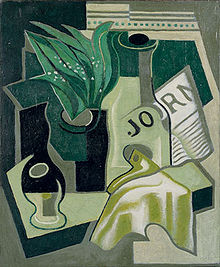Hermann Rupf
Hermann Rupf (born December 20, 1880 in Bern ; † November 27, 1962 there ) was considered one of the most important Swiss art collectors of classical modernism . The collection is looked after by the Kunstmuseum Bern . In 1954, he founded the Hermann and Margrit Rupf Foundation with his wife Margit Rupf-Wirz .
Life
Rupf was the owner of the company Hossmann & Rupf , which specialized in trimmings , gloves and buttons and was based in Bern at Waisenhausplatz 1 . During an apprenticeship at Commerz- und Diskonto-Bank in Frankfurt am Main , he met Daniel-Henry Kahnweiler , the son of a wealthy Jewish banking family from Mannheim . Kahnweiler opened a gallery for modern art in Paris in 1907 . Rupf and his wife Margit Rupf-Wirz were among the first customers and also acquired their first pictures with works by Georges Braque and Pablo Picasso . They had a lifelong friendship with Kahnweiler. With their financial help, Picasso was able to move into a new studio.
The Rupf couple had been in touch with Paul Klee since 1913 and supported the artist by buying his paintings. In 1914 they acquired a group of works with three drawings . In addition to his commercial activity, Hermann Rupf was the art critic of the social democratic Bern daily newspaper Berner Tagwacht for over 20 years . During the First World War from 1914 to 1920, Kahnweiler settled in Bern on Rupf's advice. Rupf also supported Kahnweiler in the reopening of his gallery in Paris, which was called Galerie Simon , and remained its customer.
In 1925 Rupf commissioned the Swiss artist Louis Moilliet to create a glass window for the bathroom of his house at Brückfeldstrasse 27 in Bern . In 1945 Rupf was a member of a commission that gave Lily Klee , Paul Klee's widow, "in an honorary capacity, the sole management and supervision of my husband's entire artistic estate, both artistically and financially" . With the publisher Hans Meyer-Benteli, Rolf Bürgi and the architect Werner Allenbach he founded the Klee Society , into whose possession the Klee estate was transferred. A year later they founded the Paul Klee Foundation and deposited the collection in the Bern Art Museum .
Hermann and Margrit Rupf Foundation

The childless couple founded the Hermann and Margrit Rupf Foundation on December 16, 1954 , to which a large part of the collection was transferred. The purpose of the foundation was to expand the collection, which was housed in the Bern Art Museum, and to make it accessible with publications. The collection, which originally consisted of 300 works, now consists of over 900 works thanks to further acquisitions by the foundation. It includes paintings and sculptures by the Fauvists André Derain , Othon Friesz , the Cubists Georges Braque, Pablo Picasso, Juan Gris and Fernand Léger , as well as works by Paul Klee, André Masson and Wassily Kandinsky . To mark its 50th anniversary in 2007, the 120 most important works from the collection of the Hermann and Margit Rupf Foundation were on view at a traveling exhibition at the Kunstmuseum Bern and then at the Musée de Grenoble and the Museum of Fine Arts in Budapest.
After 1954 Rupf became the foundation's first president. Works by the Swiss artists Bernhard Luginbühl , Meret Oppenheim , Markus Raetz , Dieter Roth and Otto Tschumi , as well as the specific artists Richard Paul Lohse and Max Bill were subsequently acquired by the Foundation for the collection. The collection includes works by Ad Reinhardt , Donald Judd , Joseph Beuys , Brice Marden , Joseph Kosuth , Lucio Fontana and James Turrell among contemporary, foreign artists .
The Board of Trustees in 2006 included Philippe Lévy (Bern) as President and Matthias Frehner (Director of the Bern Art Museum); Kotscha Reist (Bern); Konrad Tobler (Bern); Maurice and Renée Ziegler (Zurich); and Regina Kiener (Institute for Public Law, Bern).
Rupf was socially committed in many ways. He belonged to the Social Democratic Party and founded, among other things, the Education Committee of the Workers' Union in Bern. Daniel-Henry Kahnweiler dedicated his 1920 published book in Dephin way to Cubism on the flyleaf of my friend Hermann Rupf . Rupf was made an honorary doctor of the Philosophical-Historical Faculty of the University of Bern in 1957 . After his death, his library became the property of the faculty. Margrit Rupf-Wirz died in 1961, Hermann Rupf a year later.
literature
- Rupf Collection: Cubism in the Corridor. Hermann and Margrit Rupf Foundation . Kunstmuseum Bern, Benteli Verlag.
- The correspondence between Daniel Henry Kahnweiler and Hermann Rupf . In: Berner Kunstmitteilungen , 163/1976, pp. 1–5.
- Hermann and Margrit Rupf Foundation and Collection , exhibition catalog, Kunstmuseum Bern, 1956.
Web links
- Rupf Foundation
- Hermann and Margrit Rupf Foundation on the website of the Kunstmuseum Bern
- Zita Caviezel-Rüegg: Rupf, Hermann. In: Historical Lexicon of Switzerland .
Individual evidence
- ^ Jean-Christophe Ammann : Louis Moilliet; the complete works . DuMont Schauberg, 1972, p. 122.
| personal data | |
|---|---|
| SURNAME | Rupf, Hermann |
| BRIEF DESCRIPTION | Swiss art collector |
| DATE OF BIRTH | December 20, 1880 |
| PLACE OF BIRTH | Bern |
| DATE OF DEATH | November 27, 1962 |
| Place of death | Bern |
